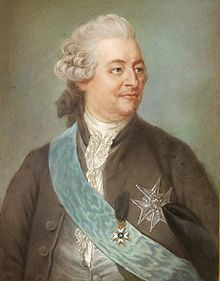Carl De Geer

Baron Carl De Geer (born February 10, 1720 in Finspång , † March 7, 1778 in Lövstabruk , Tierp municipality ) also called Charles De Geer , was a Swedish industrialist , scientist , zoologist and entomologist .
Life
At the age of three, Baron De Geer continued to grow up in Utrecht , but when he was 19 he returned to Sweden , the country of his birth. In Lövstabruk he inherited the property and the steelworks , which were very important at the time, from his childless uncle and namesake and increased the value of the factory considerably.
Since collecting some silkworms at the age of eight , he has become very interested in entomology and has gradually become a respected amateur entomologist . His main work was the work Mémoires pour servir à l'histoire des insectes , which appeared in seven volumes from 1752–1778 (an 8th volume was published by Retzius in 1883). The Mémoires describe the life history, diet and reproduction of 1466 species based on careful, patient (own) research and the review of contemporary literature. They contain 238 copper engravings as illustrations.
De Geer was not very progressive in his nomenclature of the species described. Volume 1 of the Mémoires (1752) appeared before the introduction of binary nomenclature by his compatriot Carl von Linné , in Volume 2 (1771) this is not used. In the other volumes 3–7 (1773–1778) the Linnaeus system was used, but the species name of many species consisted of three or more words instead of two words, as prescribed in the binary system. For many of the species already described and named by Linnaeus, De Geer proposed new names. Apparently, the adoption of the two-part system was only done under the impression of the zeitgeist, without De Geer being convinced of its purpose. The differences to Linnaeus are also expressed in letters to Linnaeus, in which De Geer writes: “Not everyone sees things in the same light, and people have the weakness to be too much in love with their own opinion” (October 16, 1772 ) and "If I should disagree here and there, I ask you, as before, not to blame me for this" (February 23, 1774).
As early as 1739, at the age of 19, Baron De Geer was elected a member of the Swedish Academy of Sciences in Stockholm and in 1748 a corresponding member of the Académie des Sciences in Paris . He was also a member of the Royal Society of Sciences in Uppsala .
De Geer died in 1778 and is buried with his wife in Uppsala Cathedral. His insect collections were given to the Swedish Academy of Sciences at the time, and can now be viewed in the Naturhistoriska riksmuseet ( Stockholm ). He founded a library in Lövstabruk , which included scripts by Olof Rudbeck the Elder (1630–1702) and an important collection of sheet music from the 18th century. This library was only taken over in 1986 by the Uppsala University Library as a donation from Katarina Crafoord (daughter of Gambro founder Holger Crafoord ).
Works
- Tal om nyttan, som Insecterne och deras skärskådande, tilskynda oss… Stockholm 1744–1747.
- Memoires pour servir à l'histoire des insectes. Grefing & Hesselberg, Stockholm 1752–1778.
- Valley, om insecternas alstring. Stockholm 1754.
- Treatises on the history of the insects. Müller & Raspe, Leipzig, Nuremberg 1776–1783 (posthumous), doi: 10.3931 / e-rara-22941
- Genera et species insectorum. Crusium, Leipzig 1783 (posthumously).
literature
- James Duncan: Introduction to entomology. Lizars, Edinburgh 1840.
- Carl De Geer . In: Herman Hofberg, Frithiof Heurlin, Viktor Millqvist, Olof Rubenson (eds.): Svenskt biografiskt handlexikon . 2nd Edition. tape 1 : A-K . Albert Bonniers Verlag, Stockholm 1906, p. 225 (Swedish, runeberg.org ).
Web links
Individual evidence
| personal data | |
|---|---|
| SURNAME | De Geer, Carl |
| ALTERNATIVE NAMES | De Geer, Charles |
| BRIEF DESCRIPTION | Swedish industrialist, scientist and entomologist |
| DATE OF BIRTH | February 10, 1720 |
| PLACE OF BIRTH | Finspång |
| DATE OF DEATH | March 7, 1778 |
| Place of death | Lövstabruk , Tierp municipality |
